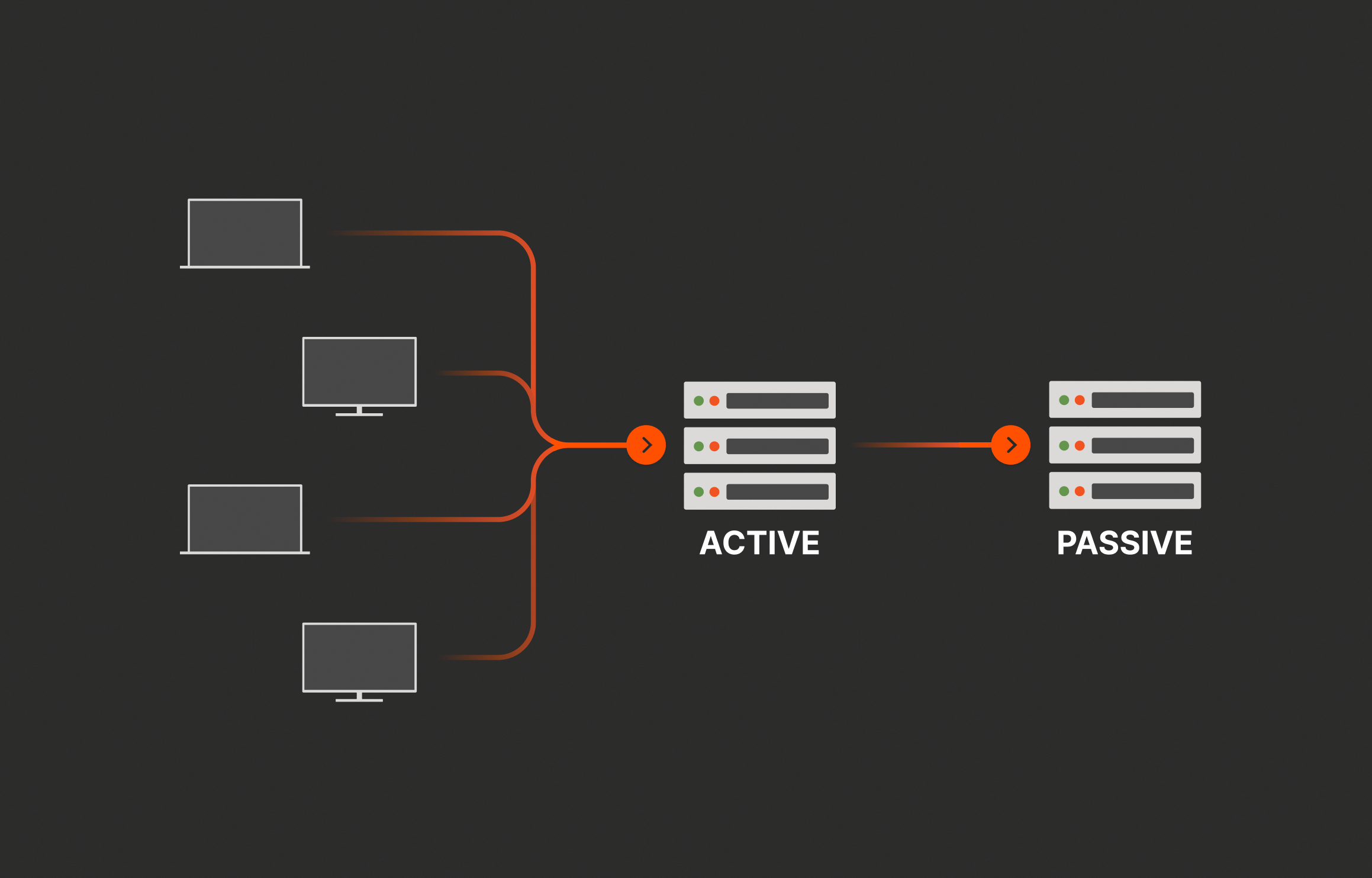Configuring high availability on massive data networks demands precision and understanding. In a digital-first era where downtime is synonymous with revenue loss and user dissatisfaction, database developers face the complexity of ensuring continuous operations while handling colossal amounts of data. Now, let’s dive into Active-active vs. Active-passive.
In this article, we’ll delve into two primary high-availability configurations—active-active and active-passive—offering insights into their mechanics, benefits, and ideal applications.
Related reading: What Is Oracle High Availability? and What Is MySQL High Availability?
What Is Active-active?
Active-active signifies a configuration where multiple nodes in a network are simultaneously active and operational. In this setup, all nodes are engaged in processing requests and can independently handle user traffic. This redundancy ensures that if one node fails, others seamlessly pick up the workload, averting disruptions in service.
How Active-active Configuration Works
Active-active operates on the principle of load distribution. Requests from users are distributed across all active nodes, promoting parallel processing. Scalability is a natural outcome as additional nodes can be added to the configuration, accommodating increased demand without compromising performance.
Why Active-active Is Fault Tolerant
The fault tolerance of active-active stems from its redundancy. If any node fails, the system redistributes the load across the remaining operational nodes, preventing data loss and maintaining uninterrupted service. Parallel processing fortifies the system, ensuring efficient utilization of resources.
Examples of Active-active Configurations
Active-active database configurations are widely used in various applications where high availability, scalability, and fault tolerance are essential. Databases supporting these platforms can distribute user requests across multiple nodes, guaranteeing seamless experiences even during peak usage periods.
Here are a few examples of systems that commonly employ active-active setups:
- Online gaming platforms: Active-active configurations enable online, multiplayer gaming platforms to distribute the game logic and player interactions across multiple servers, preventing lags in real-time interactions and ensuring uninterrupted gaming sessions even during high-traffic periods.
- Financial trading systems: Active-active configurations are crucial in high-frequency trading platforms that demand instant data processing and order execution. Multiple nodes simultaneously process trading requests, which allows for quick decision-making and minimizes the risk of financial losses due to downtime.
- Travel reservation systems: Active-active configurations enable online booking platforms for flights, hotels, and other travel services to manage fluctuating user demands, often based on seasons and promotions. These systems handle surges in booking requests by distributing the load efficiently, ensuring travelers can make reservations without delays.
- Cloud-based applications: Cloud service providers use active-active configurations to deliver services like databases, storage, and applications. In this setup, user requests are directed to the nearest and most available server, enhancing response times and overall user experience.
- E-commerce platforms: Active-active configurations help large online retail platforms manage varying levels of user traffic throughout the day, a high volume of transactions, product searches, and user interactions, ensuring smooth online shopping experiences.
- Social media networks: Active-active configurations enable social networks to handle millions of users interacting with posts, images, and videos in real time. Content has to be distributed efficiently to allow users to access their feeds, post updates, and engage with others without interruptions.
- Online streaming services: Active-active configurations help streaming platforms deliver video and audio content and handle concurrent user requests. By distributing multimedia content across multiple servers, these services can offer seamless streaming experiences, even during peak usage hours.
What Is Active-passive?
Active-passive represents a configuration where one node serves as the active instance, handling all incoming requests, while others remain passive, operating in standby mode. In the event of the active node’s failure, a passive node swiftly takes over, ensuring continuity of service.
How Does Active-passive Configuration Work?
Active-passive minimizes complexity by having a single active node at any given time. Passive nodes remain on standby, ready to assume the active role if required. This simplicity streamlines management and configuration, making it an attractive choice for specific use cases.
Active-passive Benefits from Simplicity
The simplicity of active-passive setups translates to easier maintenance and reduced operational challenges. With fewer active nodes, monitoring resources becomes more straightforward, allowing for focused attention on each component.
Active-passive Is Usually Cost-effective
Active-passive configurations often prove cost-effective due to reduced hardware requirements. Passive nodes don’t have to match the active node’s processing power, which saves on expenses. This affordability makes it an attractive choice for businesses aiming for reliability without exorbitant investments.
Examples of Active-passive Configuration
Active-passive database configurations are widely used in various applications where reliability, simplicity, and cost-effectiveness are crucial. Critical systems and applications that can’t afford any downtime often employ them to ensure swift failover and maintain operational integrity.
Here are a few examples of systems that commonly employ active-passive setups:
- Enterprise resource planning (ERP) systems: ERP systems integrate various business processes such as finance, human resources, and inventory management. Active-passive configurations ensure continuous access to critical business data. If the active node fails, the passive node takes over, preventing disruptions in operations.
- Telecommunications systems: Telecommunication networks handling voice calls and messaging services rely on active-passive configurations. If the active node experiences issues, such as hardware failure, the passive node quickly assumes the active role, ensuring uninterrupted communication services for users.
- Healthcare information systems: Active-passive setups are employed to guarantee constant availability of patient data in healthcare databases that store patient records, scheduling information, and medical histories. In emergency situations, healthcare providers need instant access to accurate information, making failover capabilities vital.
- Customer relationship management (CRM) software: Active-passive setups in CRM databases guarantee that sales and customer support teams can access customer data, sales leads, communication histories, and client information without interruptions. If the active node fails, the passive node ensures continuous access to vital customer data.
- Online banking systems: Banks and financial institutions use active-passive configurations in their databases to ensure the availability of online banking services. If the active node experiences issues, the passive node becomes active, allowing customers to access their accounts, make transactions, and check balances without interruptions.
Active-active vs. Active-passive
Now let’s look at differences between active-active and active-passive:
- Active-active involves all nodes being active simultaneously, ensuring parallel processing and high scalability.
- Active-passive operates with a single active node and standby nodes ready for failover.
Active-active and Active-passive Pros and Cons
Here are some pros and cons:
- Active-active pros: High scalability, parallel processing, fault tolerance
- Active-active cons: Complexity in configuration, potentially higher costs
- Active-passive pros: Simplicity, cost-effectiveness, efficient failover
- Active-passive cons: Limited scalability, underutilization of resources in passive nodes
Conclusion
In the realm of high-availability configurations for massive data networks, the choice between active-active and active-passive is pivotal. Active-active offers unparalleled scalability and fault tolerance, making it ideal for applications demanding continuous high performance. On the other hand, active-passive, with its simplicity and cost-effectiveness, suits scenarios where reliability and failover efficiency are paramount. Understanding these configurations empowers database developers to make informed decisions, ensuring seamless operations in the face of network challenges.

BUYER’S GUIDE, 14 PAGES
Reevaluating Your Virtualization Strategy?
Explore your options in our guide to modern virtualization.

Written By:
What is Oracle High Availability?
Let’s delve into the concept of high availability, explain why it is important in IT systems, and explore how Oracle High Availability works, its architecture, best practices, services, and the benefits and drawbacks associated with its implementation.






